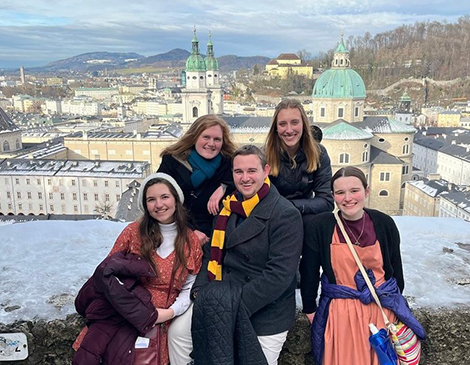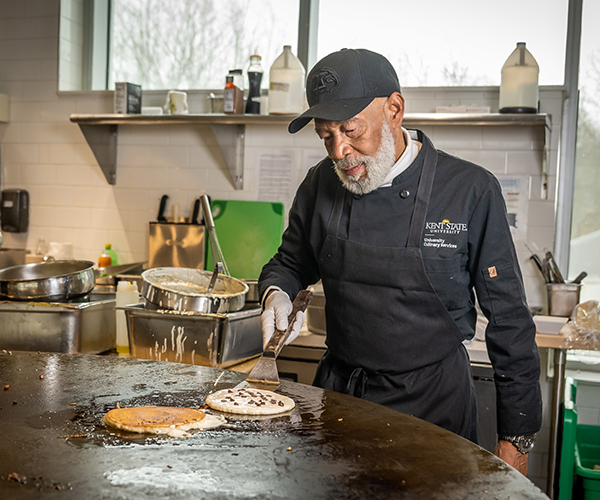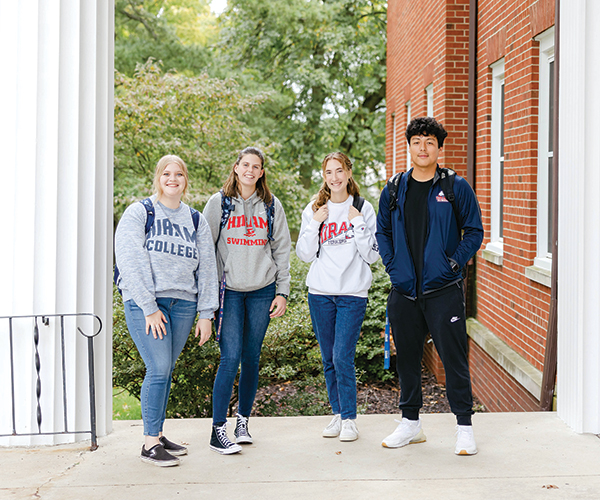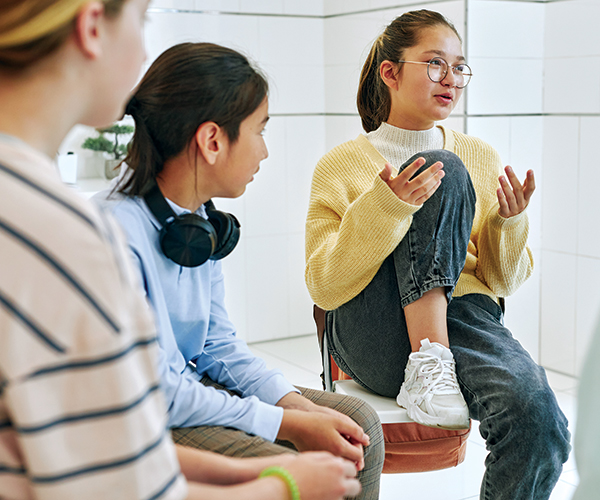“Everyone is more or less the same,” says Hannah Lesko, sharing a core takeaway from her study-away experience in Gaming, Austria, which unfolded into a trip-tic of travels to Poland, Greece and Italy, to name a few.
Lesko didn’t know any of these languages. The senior graphic design and communications major had only been on an airplane one other time. But travel experiences were a priority when considering colleges, she says. “I’m a huge people person, I love learning about people’s stories and I think you can make home wherever you go,” she says of a willingness to flex her passport with an open mind.
Lesko was all in when she discovered the Global Learning Program at Walsh University in North Canton. What she took home was far beyond speaking some conversational Romanian, navigating public transportation and working through occasional homesickness.
“One of the biggest lessons I learned was to be present,” she says. “Appreciate the little things.”
Lesko describes a backpacker sitting on the ground in front of the Vatican, “just basking in the sun.” She had taken a moment to rest. Staying in a 14th-
century monastery in Gaming, Austria, she and her new friends ritually carved time to share tea and soak in the landscape. Collin Derrig, a John Carroll University alum, expresses a similar self-
revelation from his time in Hirakata, Japan. He went away not knowing a soul. Students traveling the same semester had chosen other destinations such as Rome or Rouen, France.
“What I took away the most was to appreciate the transience of the moment. Just stop. Wander. Take in what is around you,” Derrig says. “For the first time in my life, I really learned how to let go.”
Derrig studied Japanese religions at Kansai-Gaidai University, which partners with JCU as a study-abroad destination. “It was the first time I had to be fully independent with no support network,” says Derrig, who was employed at Global Cleveland after graduation and is currently pursuing a law degree.
“You will hear that study-away is ‘transformative,’ and it is — and that can be scary for a student, but we let them know we are going to walk alongside you in this experience,” says Rachel Hosler, vice president for student affairs at Walsh University. “This is a safe way to go outside your comfort zone and challenge yourself at a young age.” After all, the world is a pretty small place.
Study-Away Today
From off-the-beaten-path destinations such as Madagascar and Nepal to domestic travel, today’s study-away extends beyond staying with a host family overseas or bunking in a different country’s college dorm. The format has also evolved. Programs include spring-break-sized excursions and short-term, professor-led experiences, along with semester and year-long trips, says Jonnathan De La Fuente, director of International Programs and Study Away at Oberlin College.
Study-away can culminate service opportunities and include internship exchanges. For example, Oberlin’s partnership with American University in Washington allows students to study policy while networking with the various governmental branches, he says.
In New York City, they can learn theater “though the lens of Broadway,” he adds. In Montana, Obies can take geological science courses. Faculty-led offerings range from French winemaking and tours exclusively taught in the language, and Russian language and culture while visiting the sights in Georgia.
“We talk to students about these opportunities before they even arrive on campus, while they are doing tours,” De La Fuente says.
Across the board, the study-away conversation is happening before students submit college applications so they can “map out their curriculum” and carve time for travel experiences, he says.
At Oberlin, an exceedingly high 60% to 80% of students engage in some type of study-away program. “We navigate the options based on their academic interests and curriculum requirements,” De La Fuente says.
The semester-long JCU in Rome is a primary study-abroad program for its students and includes internship opportunities with the Jesuit Refugee Service, directly in the Vatican or for the Vatican radio, says Melanie Hahn, director for its Center for Global Education. “Taking advantage of internships while studying abroad is one of the greatest resume builders,” she adds.
Walsh’s two-week and monthlong programs in Austria, Italy and Ireland are facilitated through university partnerships and offer flexibility for fitting in travel while managing a packed school schedule, Hosler points out.
The Big Life Lessons
The experiential piece is the most impactful. “I know I came back more confident and prepared for life than ever,” Derrig says of learning the transit system, traveling solo across Japan and spending three days on the Shikoku Henro Buddhist pilgrimage route.
In fact, walking and exploring is how Derrig calmed his nerves during the initial days while he was getting used to a completely different cultural environment far from home.
Derrig’s advice: “Don’t make the experience about yourself. Make it about experiencing a place you’ve never been. Know that it’s different than where you come from and treasure it.”
De La Fuente relates to his study abroad experiences 15 years ago as a student. “I learned how to budget,” he says. “I learned how to understand conversion rates. I also learned how to cook and discovered a love for it.”
Aside from independence, students navigate new social environments, requiring adaptability, De La Fuente says. “Oberlin is one type of environment. A student’s home is another type of environment. And abroad, their independence skills go up a notch because they are learning their way in a different culture.”
Of course, experiences like this shine on a resume whether for entering the workforce or gaining admission to graduate school, De La Fuente points out. “Students say when they put study away on their resumes and LinkedIn, they have gained more attention and inquiries from grad schools, professional schools and employers,” he says.
For more updates about Cleveland, sign up for our Cleveland Magazine Daily newsletter, delivered to your inbox six times a week.
Cleveland Magazine is also available in print, publishing 12 times a year with immersive features, helpful guides and beautiful photography and design.




